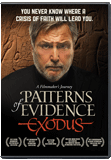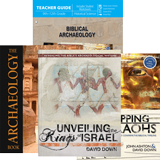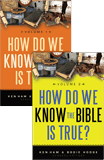
Is the Meaning of Genesis Lost in the Ancient Near East?
Christians are separated from the initial delivery of the book of Genesis by around 3,500 years. Most of us do not live in the Middle East, and we certainly do not live the same way as the ancient Israelites and the surrounding nations. Compared to Israel, our culture is estranged by time, language, practices, geography, advances in different spheres of human disciplines, and more. This leads to an important question: When we read Genesis, can we understand what was meant for the original audience?
Dr. John Walton, professor of Old Testament at Wheaton College, proposes that the basis to which we understand the meaning of Genesis is its historical setting in the ancient Near East (ANE). He has published his views for a general readership in his books, The Lost World trilogy. In this short overview we will concentrate on three basic issues:
- The importance of Old Testament Backgrounds and responsible usage for biblical interpretation;
- Walton’s use of the ANE literature and his Creation Functionality View; and
- The impact of Walton’s approach upon the traditional understanding of basic Christian doctrines.
The Importance of Old Testament Backgrounds
We begin with an overview of the Old Testament background setting of the ancient Near East (ANE). The ancient Near East can be simply explained as the nations/empires that geographically surrounded the land that God promised to Israel from the time of Abraham to around the time of the Divided Kingdom following Solomon’s reign (see picture).

The study of Old Testament backgrounds has gained increasing prominence in biblical scholarship. The excavations of ANE libraries and the decryption of ancient languages have produced many pieces of literature revealing great similarities to the biblical accounts of Creation, the Fall, the Flood, the patriarchs, and the Tower of Babel. In addition to this literature, archeological dig sites have uncovered buildings, communities, water systems, and city layouts. They have uncovered artifacts including jewelry, pottery, weaponry, and a host of other helpful keys to constructing a picture of life in ancient cultures. Dr. Victor Matthews, specialist in the social world of the ancient Near East has summarized this idea:
The gulf of thousands of years that separates us from them can be bridged, at least in part, by insights into their everyday life. Such insights can be garnered through close examination of biblical data with written and physical remains from other ancient civilizations.1
Bridging those gaps is important and can help us to better understand the text of Scripture in its setting; however, we must understand the very nature of Scripture. The Bible is God’s Word. If our interpretation of the historical setting of the ancient Near East is required for determining biblical meaning, we are placing authoritative weight on an external source rather than in the very inspiration of Scripture.
One fact that prompts us to proceed with caution is that the church has had very little access to any ANE literature until the very end of the 18th century. Much of the ANE myths that have similarities with the biblical accounts were not translated until the second half of the 19th century. This means that if the church could only understand the meaning of Genesis through the lens of “earlier” ANE literature, then the world that provides that meaning had been lost for the first 1800 years of the New Testament church’s existence. It is a “Lost World.”
Approaching the Evidence Through Biblical Supremacy
The internal testimony of Scripture is that it is God breathed and reliable in all its uses for equipping God’s people (2 Timothy 3:16). The Christian should understand that the battle has never been over the evidence, but over the interpretation of the evidence. Scripture claims to provide infallible truth and therefore interpreting the Bible through the lens of our fallible interpretation of evidence inevitably brings fallibility to the infallible. There are three helpful steps the Christian can use to reduce our susceptibility to error.
- Recognize that the Bible is to be given supreme weight in our interpretation of the world. “The Bible occupies a place of unchallenged supremacy and authority, at least to readers who accept its truth claims at face value.”2
- Christians need not be embarrassed about having a presupposition of biblical truth and neither should the skeptics be embarrassed about having a presupposition against the Bible.3 There is not a person in the world that truly comes to the evidence without a starting assumption about the past. While many claim to have a neutral position, in reality there is no such position. We either accept the biblical claim that the Word of God is fully reliable and true, or we don’t. Human reason is always informed by an authority. This is either God’s infallible Word or human autonomy.
- Acknowledging our presupposition of biblical authority, we must come to the evidence with honesty and an ability to examine sources critically.4
These steps allow us to honestly assess the evidence while affirming that the Bible is authored by humans who were divinely inspired.
An Honest Assessment of the ANE Literature Identifies the Uniqueness of Scripture
Old Testament theologian, John Currid, PhD, has identified at least three major dissimilarities in the texts of the ancient Near East compared to the similar accounts found in the Bible. In an assessment of the Genesis texts, Currid notes that there is an obvious difference in genres. First, the biblical account has all the known markings of “historical narrative” while the ANE stories show a style that is best described as “mythic narrative.”5 Second, in the creation texts, the Bible reveals a chief purpose to glorify the one true Creator God while the ANE literature displays a mythological polytheism.6 Finally, where the ANE texts hold magic as the ultimate power in the universe, the Bible reveals God as all-powerful and owing nothing to the agency of another.7
There are more distinctions to note, but these three differences alone should cause any careful historian not to place undue weight on ANE literature when studying the historical context and meaning of Scripture. Even after considering similarities, Currid notes that “the dissimilarities are not superfluous but are of great magnitude and import.”8
Ministerial Rather Than Magisterial Use
A ministerial use of the ANE is where this external literature is used as an enhancement to our understanding of the historical backgrounds of the text. Magisterial use is where the ANE literature is used to actually determine the meaning of the text. This whole issue comes down to a matter of authority. When we consider our ability to understand the world, we must understand that humans have corrupt hearts leading corrupt minds in a world corrupted by sin. We should have very little confidence in the human ability to come to a proper interpretation of past events that none of us in this present age were around to witness. Theologians make the biggest mistakes when they trust their own intellect and autonomous reasoning to assess evidence and impose their conclusions on the text of Scripture. In effect, this is the fallible attempting to reinterpret the infallible. Instead, the theologian should take care to place Scripture itself in the driver’s seat for interpreting the world we live in. It is not our understanding of the world that we force upon Scripture, but it is Scripture that guides our understanding of the world. Our starting points matter greatly.
When we acknowledge the Divine as well as the human authorship of Scripture, we understand that God was not only there to witness history but has always been sovereignly in control over it. This history is reliably recorded in Scripture through Moses, the Prophets, and the Apostles. This history recorded in the Bible is also unreliably echoed in the myths and records of the pagan nations. It should be no surprise to Christians to find legends all over the world that resemble the biblical history recorded in Genesis 1–11. The ANE is not alone in producing mythological narratives of Creation, the Fall, the Flood, and the Tower of Babel. All over the world different cultures have variations of these events recorded in their non-inspired records and legends. This is yet another indication that up until the confusion of languages at Babel, all of humanity shared a common history.
Archeology has uncovered artifacts and literature from excavations in the ancient Near East that have greatly assisted the church in enhancing an understanding of the historical setting of the world in which Israel once lived. Even so, proper use of such evidence in biblical interpretation should be used in a secondary sense of enhancing rather than determining the meaning of the biblical text. In this sense ANE literature and artifacts can serve to both augment our knowledge of historical settings and can be used in an apologetic sense as evidence that confirms the biblical record. For example, many liberal theologians once questioned the reliability of the history in Genesis because there was no archeological evidence of the Hittites in the south of Canaan (Genesis 23). Later archeological finds confirmed Hittite presence.
Only God’s Word should ever be given magisterial authority in our understanding of the world. Evidence is useful to further explain and enhance the riches of the depth of meaning that is already available in the text. This is what it means to use ANE evidence in a ministerial rather than a magisterial sense.
The Creation Functionality View
Dr. Walton’s Lost World series is a good example of what happens when, however unintentionally, the ANE texts are given magisterial authority over the text of Scripture. When outside sources are used as a basis of interpretation, this imposes foreign meaning onto the text of Scripture. Walton suggests that the ANE stories that find similarities to Genesis give us the interpretive grid for aiding our understanding of the beginning chapters of Genesis. At the same time it should be noted that Walton would strongly object to the assessment that his view gives magisterium to ANE materials. His position is that the human author and original audience of biblical text share common perspectives with the ancient world in which they lived. In this way it would seem that Walton checks his understanding of the ancient biblical text through ANE materials. Regardless of such an objection, the author of this review still sees a determinative role given to ANE texts in finding meaning in the biblical text and maintains that Walton has given magisterial authority, even if he would oppose such an idea.
Walton’s main premise is that the ANE literature reveals the ancient understanding of cosmology as a temple prepared for the gods. In this way, he proposes that ancient cosmology is more concerned with how functionality is brought to the cosmic temple rather than the material creation of all things. This is likened to the inauguration of Solomon’s temple. The temple was already physically standing, but the inauguration of that temple was a process that took seven days culminating in all functioning elements of the temple being put in place. This then is the explanation used for Genesis 1 and 2. It is no longer (after 2,000 years of church history) to be seen as an account of God materially creating, but in inaugurating Eden, and eventually the remainder of creation, as His cosmic temple. This view can be quite confusing and requires a much fuller explanation, which can be found in my review of his latest book, “The Lost World of Adam and Eve: A Response.” Even though Walton is not discussing the age of the earth or evolution, he does use significant space in his book to claim that his functionality view is perfectly compatible with modern evolutionary beliefs. It isn’t about theistic evolution, but it allows for it.
“The Lost World” element in Walton’s trilogy indicates that it is only upon recent discoveries and study of ANE literature that scholars have been able to reconstruct a true understanding of the context of the Old Testament Scriptures. This context he proposed is vastly different than the way the church has traditionally understood Genesis as an account of material origins (it’s physical origins).9 Upon investigating Walton’s work, the reader will soon find extensive word studies in the beginning chapters of Genesis where references to God’s acts of material creation have been understood in terms of bringing functionality to a creation that is already materially present.
Doctrinal Changes
One thing that is very evident in the Lost World trilogy is that Genesis is a book that gives foundational coherency to the remainder of Christian doctrine. If we reinterpret the meaning of Genesis, we will inevitably change the meaning of Creation, sin, salvation, and Consummation. For this author, the Creation Functionality view is an example of how major doctrines of the Christian faith are impacted when we lose the material account of the creation in Genesis. What follows is a list showing the basic definitions of doctrinal truths traditionally held in the church compared to emphases being made in the Creation Functionality view.
| Traditional Understanding | Creation Functionality View | |
|---|---|---|
| 1 | Genesis 1 describes material creation. | Genesis 1 describes functions only—not material creation. |
| 2 | “Very good” describes the physical creation. | “Very good” describes order brought to non-order. |
| 3 | God “rests” from creation work on the seventh day. | “Rest”—God/gods dwell in temple |
| 4 | Genesis 1:26–28 is the creation of Adam and Eve. | Genesis 1:26–28 is not unique creation of humans. |
| 5 | Genesis 2 is a focus on the sixth day. | Genesis 2 is a sequel to Genesis 1. |
| 6 | Adam and Eve are first humans. | Adam and Eve may or may not be first humans. |
| 7 | Serpent is Satan. | Serpent is one of a number of chaos creatures. |
| 8 | Sin is rebellion against God and His law. | Sin is the act of acquiring wisdom illegitimately and desiring to bring order to the creation in our own way. |
| 9 | Sin is imputed from Adam to all mankind because Adam is the original Father of humanity. | Adam is an archetypical representative of the human race and sin is dispursed through a world of disorder. |
| 10 | Salvation necessary for redemption of believers and reconciliation of all things | Salvation emphasized in terms of getting the ordering of creation back on track |
The depth of confusion that reigns over essential doctrines such as sin and salvation is significant. When Genesis 1–3 is deemed to emphasize functional significance, the definition of sin becomes more concerned with functional impairment rather than a personal disobedience resulting in corruption and the reality of physical and spiritual death. The result in Walton’s book about Adam and Eve is that the major emphasis of salvation doctrine is given to human function in the creative purpose of God rather than our redemption from sin and death through the blood of Christ.
Conclusion
The application of Dr. Walton’s use of the ANE texts has resulted in extensive retranslation of the commonly held word meanings, a rejection of the significance of God’s materially creative acts in the history of the early chapters of Genesis, and new emphases impacting definitions of key Christian doctrines. An acceptance of Dr. Walton’s view must conclude that the Church has been without access to the real meaning of Scripture for over 1,800 years.
Christians must be careful to maintain that God’s Word alone has infallible authority. While ANE texts can be valuable aids in enhancing our understanding of the historical background of the biblical text, they do not determine or override the meaning of the text. When we start with Scripture to determine truth, it is the Bible that sheds light on the distortions of history presented in the mythical narratives of the world.
Ultimately, while Dr. Walton endeavors to suggest that Genesis 1 and 2 are about functionality in the material creation rather than God’s act of materially creating, he does advocate that the Creation Functionality view allows for any explanation of origins that may be proposed by the modern consensus of the scientific establishment. Therefore, by starting with man’s interpretation of the ANE materials to interpret Scripture, Walton allows for man’s ideas of evolution that disregard the biblical account of history. At both ends, Scripture becomes subject to human autonomy rather than respected as the authority. Dr. Walton is very prepared to consider evolutionary explanations for cosmology and life. The Creation Functionality view and evolutionary thinking are compatible in two ways. They do not require a literal reading of Genesis as a historical narrative and, if held consistently, they inevitably redefine key Christian doctrines and bring a dangerous confusion to the doctrine of salvation.
While Answers in Genesis consistently affirms that the origins debate and the age of the earth is not a salvation issue, the Creation Functionality view is a good example of how a distortion in the understanding of Genesis can have a negative effect on the understanding of the very nature of the salvation doctrine. If Christians are to uphold the gospel message of Jesus consistently, the historical authenticity of Genesis as an account of material origins and original sin from Adam as the father of all humanity remains crucial.
Bibliography
Currid, John D. Against the Gods: The Polemical Theology of the Old Testament. Wheaton, Illinois: Crossway, 2013.
Matthews, Victor H. Manners and Customs in the Bible: An Illustrated Guide to Daily Life in Bible Times. 3rd edition. Baker Academic, 2006.
Merrill, Eugene H. Kingdom of Priests: A History of Old Testament Israel. 2nd edition. Grand Rapids, Mich: Baker Academic, 2008.
Walton, John H. The Lost World of Genesis One: Ancient Cosmology and the Origins Debate. Downers Grove, Ill: IVP Academic, 2009.
Walton, John H., and Brent Sandy. The Lost World of Scripture: Ancient Literary Culture and Biblical Authority. Downers Grove, Illinois: IVP Academic, 2013.
Footnotes
- Victor H. Matthews, Manners and Customs in the Bible: An Illustrated Guide to Daily Life in Bible Times, 3rd ed. (Grand Rapids, MI: Baker Academic, 2006), 11.
- Eugene H. Merrill, Kingdom of Priests: A History of Old Testament Israel, 2nd ed. (Grand Rapids, MI: Baker Academic, 2008), 31.
- Ibid.
- Ibid.
- John D. Currid, Against the Gods: The Polemical Theology of the Old Testament (Wheaton, IL: Crossway, 2013), 60.
- Ibid., 46.
- Ibid., 41.
- Ibid., 60.
- John H. Walton, The Lost World of Genesis One: Ancient Cosmology and the Origins Debate (Downers Grove, IL: IVP Academic, 2009), 21–35.
Recommended Resources

Answers in Genesis is an apologetics ministry, dedicated to helping Christians defend their faith and proclaim the good news of Jesus Christ.
- Customer Service 800.778.3390
- © 2024 Answers in Genesis






